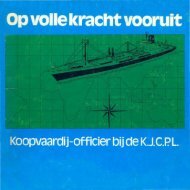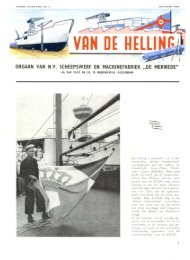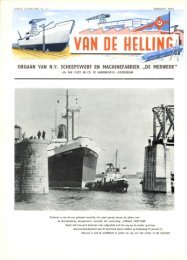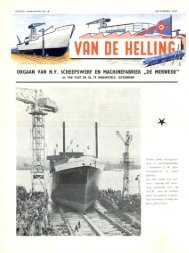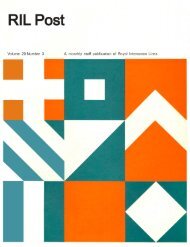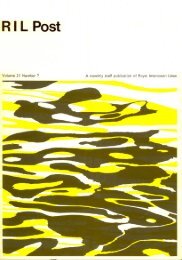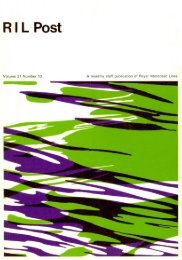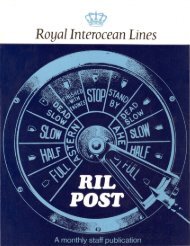Create successful ePaper yourself
Turn your PDF publications into a flip-book with our unique Google optimized e-Paper software.
R I L <strong>Post</strong><br />
Volume 18 Number 3 A monthly staff publication of Royal lnterocean Lines
Monthly<br />
Staff Magazine<br />
of<br />
Royal lnterocean Lines<br />
( Koninklijke Java- China<br />
Paket vaart Lijnen N.Y .)<br />
A Member of the<br />
Netherlands Shipping Union<br />
Group of Companies<br />
VOL. XVIII No. 3<br />
MARCH 1971<br />
P.O. Box 725, HONG KONG<br />
ED ITOR<br />
Mrs L.M. Petty<br />
AREA CORR ESPONDENTS<br />
HOLLAND - P.W.A. Keller<br />
JAPAN - H. Oike<br />
AUSTRALIA - B. Polai n<br />
AFR I CA - C. M oes<br />
S. AMERICA - P. van Schaardenburg<br />
SINGAPORE - J. Tan Swee Ann<br />
SHIPS<br />
STAFF<br />
FEATURES<br />
Straat Banka<br />
Straat Clarence<br />
Fleet Facts<br />
Tjitarum<br />
Straat C- ..<br />
Ned/loyd Kembla<br />
CONTENTS<br />
40 Years Anniversary<br />
25 Years A nniversa ries<br />
Poem for Chief Eng ineer<br />
Meteorological Award<br />
t .s . Simulator ..<br />
10 Years Ago ..<br />
Stamp Collectors Ahoy!<br />
Bulk Palm Oil to Shimanzi<br />
There is a nice mixture this month - just as<br />
Straat Clarence loaded o n her way to Japan<br />
for lengthening ( pages 50/51). We are indebted<br />
both t o Captai n Adamse and Act ing<br />
Third Officer Groenendijk for the pictures.<br />
Companies Anniversaries continue to be in<br />
the fo refront (pages 48/ 9 and 52/ 3) but<br />
there will be a slowing down during 1971.<br />
1972, however, w ill see the numbers rising<br />
agai n, and the following t wo years w ill produce<br />
really bumper crops.<br />
New ships need new trai ning techniques.<br />
Pages 46/ 7 contain a most interesting description<br />
of the navigational simulator in Holland.<br />
For the rest, honours are even between staff<br />
and sh ips - a well-trimmed ship in fact.<br />
43<br />
50 _1 1<br />
43<br />
56/7<br />
44<br />
45<br />
page<br />
48<br />
49, 52/ 3<br />
57<br />
55<br />
46/7<br />
59<br />
59<br />
56<br />
A spout poured oats into Straat<br />
Cl arence's hold No. 5 at Geelong<br />
b efore she sail ed for Japan .<br />
(below) The jumboizing is a<br />
very exact oporation .<br />
Contents. with the exception of artic!es derived from other sources. may be<br />
reprinted; acknowle dg e me nt o f the sou rce. how eve r. w ou ld be appre ciated . . ..
As Tjiluwah laid at the foot of M ount W ellington in Hobart, Straat Banka passed on her way to load zinc<br />
at Risdon. W e are indebted to Don Stephens of Hobart for permission to reproduce this photograph.<br />
FLEET FACTS<br />
The charter ship Jelunga was re-delivered to owners<br />
in mid- February.<br />
The three Nedlloyd vessels which w ill be transferred<br />
to RIL during 1971 will be re-named as follows:-<br />
Randfontei n - Nieuw Holland<br />
Kloosterkerk - Straat Korea<br />
Koudekerk - Straat Kobe<br />
s.s. Tjipondok has been sold to Li Chong Steel &<br />
Iron Works Co. Ltd ., Taiwan, and w ill be delivered<br />
to purchasers at Kaohsiung in mid-March.<br />
RIL <strong>Post</strong> get s i ts first glimpse of the New Zealand port of<br />
Tauranga from Chief Officer H.H.A.E. Kwaad ( Scraat Cumberland)<br />
who was flying in a Piper Cub up to Auckland with<br />
Captain J.L. van Schoondrager when the latter went on<br />
leave. Straat Cumberland was loading milk powder on her<br />
northbound voyage in the New Zealand-East Asia Service.<br />
43
DOUBLE PARKING<br />
When Straat Hobart arrived at Santos on 13th<br />
December, port congestion held her in the stream to<br />
await a berth. Straat Agulhas arrived the following<br />
night, timepressed on her west-bound voyage. The<br />
two ships were successfull y double-banked during<br />
a dark night, and by daybreak of the 15th, 500 tons<br />
had been discharged to Straat Hobart. Straat Agulhas<br />
then had a berth awaiting her, but this picture was<br />
taken in the earl y morning light before she moved up.<br />
- 44<br />
IN JAPANESE<br />
The massive crane in NKK's Asano Dockyard<br />
at Yokohama lifts a new 19.5 metre section to<br />
fit forward of the superstructure on a Straat Cship,<br />
and the whole slides very smoothly into<br />
place amidships.<br />
The jumboizing of Straat Clarence was finished<br />
on 22nd February and Straat Chatham followed<br />
at the end of the month for her four-week<br />
conversion programme.<br />
HEAVY
DOCKYARDS<br />
TRAFFIC<br />
The third of Ned/loyd's five 'K' vessels, Ned/loyd<br />
Kembla, was launched on 12th January by Mrs<br />
E.M . van Rhoon, wife of RIL's Manager for<br />
Japan. The ship was constructed at the Kobe<br />
Shipyard & Engine Works of Mitsubishi Heavy<br />
Industries Ltd.<br />
The name of the fifth ship in this series will<br />
be Ned/loyd Katwijk, and not 'Kampen' as<br />
previously announced.<br />
CROSSROADS?<br />
The photographer had some difficulty in crossing to<br />
the middle of the busy Shaukiwan Road, but when<br />
the traffic cleared suddenly, there - looking rather<br />
larger than life - was the funnel of Tjitarum. It was<br />
something of a surprise to find the vessel apparently<br />
on a collision course. She was undergoing DMO in<br />
Taikoo Dockyard, Hong Kong, and a curving sweep<br />
of the road produced the illusion.<br />
45 -
NSU's new containership, ABEL<br />
TASMAN, like others of her vast<br />
size, will present certain manoeuvring<br />
problems to her Master<br />
and officers. They are not unprepared,<br />
however, for they have<br />
been getting ready for the job<br />
without ever having been at sea<br />
with the ship, thanks to the 'ship's<br />
simulator'.<br />
This comprehensive simulator, the<br />
latest development of earlier experimental<br />
models. came into being<br />
in March, 1970 and is the only<br />
one of its kind in the world. It<br />
was constructed by the Dutch<br />
Organization for Applied Physical<br />
Research, together with the<br />
Technical University at De lft. In<br />
combination with an analogue<br />
computer, slide projector and a<br />
registration apparatus, the new<br />
simulator gives officers ashore an<br />
opportunity to study the movements<br />
of a ship in all weather. sea<br />
and coastal conditions.<br />
In 1969, the Board of Directors<br />
of VNS, who had been following<br />
developments with interest, decided<br />
to have ABEL TASMAN<br />
put on the simulator. So it was<br />
possible for some Nedlloyd M asters<br />
and Chief Officers to make<br />
'trial runs'.<br />
It was a five-day course during<br />
which they were 'berthed' on the<br />
fourth floor of a large building in<br />
Delft. Inside was a complete replica<br />
of a wheelhouse. equipped<br />
with every modern navigational<br />
aid except radar. Decca charts<br />
were used, and particularly useful<br />
was the instrument indicating the<br />
vessel's turning speed.<br />
T.S. ' SIMULATOR '<br />
A perfectly designed<br />
and familiar bridge.<br />
The view from the wheelhouse,<br />
over the foreship, of the horizon,<br />
sea, coast or harbour entrance<br />
(see photographs) is obtained by<br />
projecting a number of slides on<br />
to a curved screen. T he relative<br />
movements of the coastline as the<br />
ship 'approaches' are very realistic<br />
and true to life.<br />
A computer has been fed with all<br />
the re levant details of t he ABEL<br />
TASMAN, measurements, characteristics<br />
of steering and propulsion,<br />
and synchronizes these with<br />
rudder and engine manoeuvres to<br />
cause the appropriate picture to<br />
be projected on to the screen and<br />
to give the bridge instruments<br />
exact information. The unobstructed<br />
view covers an arc of 120°,<br />
60° to each side.<br />
In order to be able to study the<br />
novices' efforts afterwards. the<br />
results of the manoeuvres are<br />
automatically recorded.<br />
The simulator has a wide range<br />
of possibilities, both in regard to<br />
a ship and her characteristics and<br />
also in connection with outside<br />
influences.<br />
Speed can be altered by increasing<br />
or decreasing engine revolutions,<br />
stopping and/ or reversing. The<br />
corresponding c hanges. as well as<br />
the drift caused by the propellor,<br />
are brought into the calculations.<br />
Course alterations in open sea are<br />
unrestricted, but near a coastline,<br />
m aximum alterations are 90° to<br />
starboard and 60° to port.<br />
Normal visibility and fog can be<br />
simulated. Winds can be given<br />
46<br />
any direction or force, with variations<br />
if required, and the same<br />
can be said of currents with their<br />
resulting effects on the vessel.<br />
Shallow water can be simulated,<br />
but for ABEL TASMAN, only deep<br />
water was used.<br />
When simulating the open sea,<br />
there is no restriction on the<br />
distance to be covered. The maximum<br />
distance from a coast is<br />
about 10 miles, the coastline itself<br />
being about 8 miles long. When<br />
approaching a port, a distance of<br />
about 3 miles is simulated from<br />
ship to breakwater-heads.<br />
The coastline has three leading<br />
lines and landmarks for bearings.<br />
The port area has one leading<br />
line, breakwaters, towers, cranes<br />
etc. VHF is installed to allow<br />
ship/ shore traffic and shore radar<br />
control.<br />
The five-day programme for the<br />
Nedlloyd officers was as follows:<br />
1st Day: explanation of the<br />
simulator. Sailing in leading<br />
lines.<br />
2nd Day: sailing in leading lines,<br />
combined with anchoring.<br />
3rd Day: bringing the ship into<br />
port.<br />
4th Day: repetition of 2nd and<br />
3rd days.<br />
5th Day: man-overboard manoeuvres,<br />
Williamson turn,<br />
turning circles and stopping<br />
distance. Repetition of 'port<br />
manoeuvres'.
The following is an impression from one of those who took part:<br />
" ... We were surprised to learn that we<br />
would take turns as master, navigator<br />
and helmsman. A far-reaching democratic<br />
proposal- possibly through the<br />
influence of the students of this city?<br />
The first impression was very pleasant,<br />
coffee was excellent and abundant, the<br />
catering staff female and a treat to look<br />
at . After a short introduction, we were<br />
led via the acclimatisation-room (in<br />
order to get used to the reduced light<br />
intensity), to our working area, the<br />
bridge. This was perfectly designed<br />
and equipped with all the navigational<br />
aids known to us. Everyone felt at<br />
home straight away, the more so because<br />
here too the chart pencil was<br />
missing!<br />
When (in connection with extensions<br />
to the building) someone started to<br />
work with an air-chisel, we so much<br />
imagined ourselves to be at sea that<br />
one of our number opened the wheelhouse<br />
door and yelled to the bosun to<br />
enquire if it w as necessary to chip the<br />
deck today.<br />
It was nevertheless a busy voyage, in<br />
which sometimes two ports per hour<br />
were called at. heavily testing the endurance<br />
of the crew. The weather was<br />
completely disorganized too: though it<br />
was fine outside, we for the most part<br />
encountered wind Force 8-9 and fog.<br />
The ports we called at were not up to<br />
date. were partly silted up with narrow<br />
entrances, which again were obstructed<br />
by w recks. Pilots did board the vessel<br />
but they never gave us any advice.<br />
The problems to be solved va ried from<br />
normal to difficult- if not unsolvable.<br />
One exercise (entering a port} topped<br />
the list. After a few mishaps, one of<br />
the trainees finally succeeded in entering<br />
port safely. Instructions were as<br />
follows:<br />
Initial speed 10 knots. wind force<br />
9 abreast from starboard, current 3<br />
knots from starboard and 4 points<br />
abaft the beam. The pilot had to be<br />
picked up 1500 metres closer in, speed<br />
3 knots again. 1500 metres closer to<br />
the port, a wreck obstructing the<br />
harbour entrance had to be passed.<br />
The entrance itself was then 750<br />
metres away and only 350 metres<br />
wide because of silting.<br />
During the course. it so happened that<br />
we embarked pilots without making<br />
lee, going at a speed of 9 knots, sailed<br />
over wrecks, and stranded the vessel<br />
without being summoned to a Board<br />
of Enquiry!<br />
When we signed off. we had learned<br />
what we could do with the vessel. but<br />
we also had found out what not to do.<br />
We parted in good spirits, having obtained<br />
much experience which will certainly<br />
be of va lue when in the early<br />
Spring of 1971 the t.s. Simulator will<br />
come to life in ABEL TASMAN."<br />
The view ahead from the wheelhouse gives an accurately simulated coastline of about 8 miles wide.<br />
M aximum distance from the coastline is about 10 miles, and as the 'ship' approaches a port, a<br />
distance of about 3 miles is simulated from ship to breakwater-heads.<br />
47
Mr E.M . van Rhoon<br />
A very important occasion was<br />
ce lebrated in the Tokyo M anagement<br />
office on 6th J anuary, the<br />
anniversary of 25 years of service<br />
to RIL by Mr E.M . van Rhoon,<br />
Manager for Japan. Mrs van Rhoon<br />
and their daughter were present<br />
as well as Managers from the<br />
Japan coastal offices and shore<br />
staff from Tokyo and Yokohama.<br />
Mr van Rhoon left Holland aboard<br />
the NIEUW AMSTERDAM in<br />
October 1945 and arrived at<br />
Djakarta from Penang by TEGEL<br />
BERG exactly on 6th January,<br />
1946. Indonesia then claimed him<br />
for most of the next eight years:<br />
in the early stages he worked<br />
not only for JCJL but also for<br />
'NICA' (Netherlands Indonesian<br />
Civil Administration) , 'N ISO' (N.I.<br />
Shipping Organization) and ' NIHE'<br />
( N .I. Harbour Establishments) in<br />
plans for rebuilding and reconstruction<br />
after the holocaust of<br />
war.<br />
A very much understaffed Shanghai<br />
office saw Mr van Rhoon for<br />
nearly three turbulent yea rs between<br />
'47 and '50; otherwise, it<br />
25TH ANNIVERSARY<br />
Mr W eissink made the presentation to Mr van Rhoon. watched by Mrs van Rhoon.<br />
was Tg. Priok, Tg. Perak, Djakarta<br />
and M akassar until 1954 whereafter<br />
he worked alternately in HK<br />
HO and HK MH. 1959 saw him<br />
back in Djakarta as General Manager<br />
for Indonesia for just a year<br />
and then he was posted to Hong<br />
Kong as Manager of the Freight<br />
Department, becoming 'Chef van<br />
Dienst' in 1961 . Mr van Rhoon<br />
has been Manager for Japan since<br />
March, 1963, with the exception<br />
of three months in 1966 when he<br />
was Manager for Hong Kong &<br />
China.<br />
Throughout all these years, Mr<br />
and Mrs van Rhoon have built up<br />
a wide circle of friends, not only<br />
as hore but also amongst seagoing<br />
staff, as a result of their generous<br />
hospitality.<br />
Mr J. W. H. Weissink (Tokyo<br />
Man.), on behalf of Managing<br />
Directors, presented Mr van<br />
Rhoon with a miniature Japanese<br />
garden lantern, representing the<br />
original (weighing one ton!) which<br />
will be installed in the garden of<br />
his house in South Africa. A<br />
movie camera from all RIL staff<br />
49<br />
in Japan was also presented, and<br />
an unusual 'extra' was a framed<br />
caricature which appeared in a<br />
local paper a little earlier (see<br />
page 54) . A bouquet of roses was<br />
presented to Mrs va n Rhoon.<br />
Telegrams from practically all<br />
parts of the world were read out,<br />
including one from the National<br />
Health Insurance of Japan (!!).<br />
In his reply, M r va n Rhoon recalled<br />
the past 25 years. He paid<br />
tribute to his wife for her unfailing<br />
support and thanked all RIL staff,<br />
especially t hose in Japan, adding<br />
that we are now part of a Company<br />
which has become very big,<br />
having a fleet of more than 150<br />
vessels (including newbuilding)<br />
against the five w hich formed the<br />
JCJL fleet w hen he arrived in<br />
Djakarta. As to J apan, it was<br />
neither European nor Oriental:<br />
Japan was Japan itself, with many<br />
differences which added to the<br />
interest of the country. He concluded<br />
with a toast to the future<br />
of the Company.
STRAAT<br />
CLARENCE-<br />
BULK CARRIER<br />
" As your loading programme is<br />
somewhat out of the ordinary,<br />
would it be possible for you to<br />
arrange a contribution for the RIL<br />
post?" wrote Area Correspondent<br />
Bruce Polain in Sydney. Well for<br />
Burnie<br />
Bulk<br />
Cargo<br />
Wharf<br />
an "old teaship" it certainly was<br />
out of the ordinary. Just to mention:<br />
from Sydney, pallets carbonblack:<br />
from Burnie, 2000 tons lead<br />
concentrates in bulk, plus one<br />
tank tallow: from Risdon, 700 tons<br />
zinc: from Melbourne, 1450 tons<br />
aluminium and about 3000 bales<br />
of wool: and last. but certainly<br />
not least. 4000 tons of oats in<br />
bulk from Geelong.<br />
To get this al l in during a single<br />
coastal voyage was not so simple.<br />
Said Chief officer Edsen "if all my<br />
hairs do not turn grey this time,<br />
they probably never will". Still<br />
we could cope with the technical<br />
problems somehow, be it that<br />
detailed instructions from NO regarding<br />
the fitting out of the<br />
vessel had to be observed.<br />
50<br />
The loading of the 2000 tons lead<br />
concentrates in Burnie on 12th<br />
December went rather smoothly.<br />
The modern conveyorbelt bulkloader<br />
can do about 1000 tons<br />
per hour, but since we required<br />
proper trimming by means of the<br />
- " for the first time tried out"<br />
trimming machine, loading took<br />
t he best part of the day. After<br />
loading the zinc at Risdon the<br />
following night we bade farewell<br />
to Tasmania and hurried back to<br />
the mainland where another busy<br />
programme was waiting in Melbourne.<br />
In view of the approaching date<br />
for jumboizing in Japan, the ship<br />
was very time-pressed and every<br />
effort had to be made to sail before<br />
Christmas. Soon the noise<br />
of carpenters hammering away at<br />
shifting boards made it obvious<br />
that with respect to the oats in<br />
bulk " the die had been cast".<br />
Still it was far from a gamble.<br />
Endless conferences with Office<br />
staff, Cargo Inspector, NO, Hea lth<br />
Dept. Surveyors, Stevedores and<br />
Contractors about how it could<br />
and should be done. Everybody<br />
had something to say and we<br />
w ere already yearning for the<br />
wide open sea and to be one's<br />
self again.<br />
It must be said though that there<br />
w ere quite a few stowage problems.<br />
For example it was agreed in<br />
Geelong <br />
approaching<br />
the silo<br />
berth and<br />
( r) spouts<br />
in position<br />
over the<br />
hat ches
principle that the hatch-coam ings<br />
should function as feeders but in<br />
the case of No. I hold the coaming<br />
was too small to contain at least<br />
the m inimum 2"., of the oats in<br />
that hold. To oblige, it was necessary<br />
to reduce t he space in t he<br />
hold by other cargo, which understandably<br />
had to be well covered<br />
and protected.<br />
To discharge and to load general<br />
cargo such as wool and aluminium,<br />
and to fit out for grain at the same<br />
time, required continuous supervision<br />
by t he Chief Officer. It<br />
looked as if we could just make<br />
it before the holidays but then a<br />
few bugs found under the fixed<br />
ceiling of No. II hold by t he Hea lth<br />
inspector put a rod in the wheel.<br />
Faraway Canberra said " Methyl<br />
Bromide" and that was it. Could<br />
the vessel afford to stay over the<br />
Christmas days in order to have<br />
No. II hold fumigated? Head Office<br />
confirmed that it could and definite<br />
arrangements were then made for<br />
this operation in Geelong.<br />
Methyl bromide, which is heavier<br />
than air and thus needs long airing<br />
by means of forceful blowers,<br />
meant t hat everybody had to leave<br />
the ship for two days. To find<br />
accommodation during the Christmas<br />
season for about 60 people<br />
at the drop of a hat is not easy,<br />
but tall Mr Robert Purnell, our<br />
Geelong Agent, managed somehow.<br />
The officers went to the<br />
Carlton Hotel, the M alayan deckcrew<br />
and the Chinese engineroom<br />
department, looking rather bewildered,<br />
shared the Grand Central<br />
Hotel opposite, and the Catering<br />
department disappeared into the<br />
White H:Jrt Hotel, o block further<br />
awoy.<br />
Soon we got used to hearing the<br />
same Christmas carols in the<br />
d iningro::>m at breakfast time,<br />
lunch time and dinner t ime and<br />
although the hotel staff perhaps<br />
considered us strange birds, we<br />
found the atmosphere typically<br />
congenial Australian. Less satisfied<br />
with the Australian diet were the<br />
crewmembers across the street,<br />
but fortunately t here happened to<br />
be a Chinese restaurant next door<br />
which helped.<br />
In the meantime Straat Clarence,<br />
lonely along Cunningham Pier with<br />
flags V E (ship being fumigated)<br />
fly ing , was kept under close surveillance<br />
by the Health officials and<br />
our two duty office rs w ho had set<br />
up quarters in the gatekeeper's<br />
shed. Because of the deadly nature<br />
of t he gas, t he w harf was<br />
declared out of bounds through<br />
impressive skull - and -crossbones<br />
notices.<br />
On Christmas day we all trooped<br />
back to the ship after lunch and<br />
truly everybody was happy to be<br />
home again.<br />
The next morning Straat Clarence<br />
moved to the silo berth where a<br />
set of spouts was lowered into<br />
the hatches. From some distance<br />
it looked as if a huge hand had<br />
placed its fingers on the decks.<br />
The speed of loading was tremendous.<br />
So was the accummulation<br />
of chaff dust around us which<br />
caused itching as if suddenly an<br />
outbreak of prickly heat had taken<br />
place. When Straat Clarence sailed<br />
for Japan late on Sunday<br />
night of 27th December she was<br />
full and down. Her decks were<br />
still covered with an inch thick<br />
layer of chaff when the tugboats<br />
pulled her off, but this was soon<br />
washed away and we were happy<br />
to be moving once more.<br />
51<br />
M.M. Adamse.<br />
1. Chief Officer R. Edsen & Actg. 3/0<br />
J .M. Groenendijk supervising loading of<br />
oats.<br />
2. Enjoying their Christmas dinner are<br />
(1. to r.) 4/E R. den Hartoog, Actg.<br />
3/0 Groenendijk, Actg. 3/E D.W. Bras,<br />
4/E J.L.M. Geuskens.<br />
3. Pushing through the Pacific on the<br />
way to Japan.<br />
1.<br />
2.<br />
3.
Once again TJILUWAH was the scene of the celebration<br />
of a 25-year anniversary, this time on 19th<br />
January for Chief Engineer Beckers. Mrs Beckers<br />
and thei r two children were there, as well as quite<br />
a number of w ives. As Mr Terwogt said, this gave<br />
a very pleasant and homely air to the occasion.<br />
Mr Beckers started his career with the KPM in<br />
1945 and sailed- like so many others- on board<br />
Rangitiki for Australia, w here his first posting as<br />
Fifth Engineer was to the Merak.<br />
During his career, t he Chief Engineer had seen some<br />
excitement: in 1947, a fire broke out on board s.s.<br />
SWARTENH ONDT, and for the part he played in<br />
helping t o extinguish it, Fifth Engineer Beckers received<br />
a silver cigarette case from Managing Directors<br />
of the KPM . Later, in June 1948, fires broke<br />
out simultaneously in hatches Nos. I and V I of m.v.<br />
RUYS, and in recognition of his actions on that<br />
occasion, Acting Fourth Eng ineer Beckers received a<br />
gold watch from M anaging Directors of the KJCPL.<br />
On 28th December, 1945, Apprentice Officer Tj. van<br />
der Molen signed a contract of employment with<br />
M essrs. KPM in London. Unlike other recent 25th<br />
Anniversaries, this happy event was celebrated on<br />
the exact date.<br />
Captain Tj. van der Molen<br />
Chief Engineer F.M .H. Beckers<br />
Mr Beckers was promoted to Chief Engineer in 1959<br />
and a considerable part of his service has been on<br />
board passenger ships. He is know n for his devotion<br />
to duty - a quality he has always displayed - and<br />
his high standards are much appreciated by the<br />
Company.<br />
So saying, Mr Terwogt pointed out that a second<br />
watch would not be appropriate and presented the<br />
Chief Engineer w ith a Cine Camera instead on behalf<br />
of the Board of Directors and his colleagues, adding<br />
that he hoped that there would be m any more years<br />
to come.<br />
Captain J . Maan then presented a cine projector<br />
from the officers (the entire engineroom crew had<br />
earlier given Mr Beckers an engraved silver cup)<br />
and fl owers were given to Mrs Beckers, with sm all<br />
tokens tor Robert and Ernestine.<br />
Ch ief Engineer Beckers made a s hort speech of<br />
thanks and concluded w ith a toast for the future<br />
of RIL - " bigger and better."<br />
In the Scheepvaarthuis, some of the Amsterdam<br />
staff and officers on leave gathered to meet Captain<br />
and Mrs van der Molen, and a bouquet of flowers<br />
was presented to the latter.<br />
Mr van der Schalk, in his address, said that this<br />
was the first time he had had the pleasure of doing<br />
so in connection w ith a ' floating' anniversary. He<br />
recalled Captain van der Molen's long service, of<br />
which nearly ten years had been in the rank of<br />
Captain, and presented him with the Company's<br />
token of appreciation, an engraved gold-watc h. He<br />
concluded by wishing the Captain m any years of<br />
good hea lth and hoping that he would continue w ith<br />
his usual cheerfulness to give his energy to the<br />
Company's business.<br />
52<br />
25TH ANN<br />
After the reading of the congratulatory telegrams,<br />
Captain van der Molen thanked everyone, and the<br />
gathering relaxed into a friendly and animated party.
VERSARIE S<br />
Captain W.H. Schroder<br />
A lt hough falling due on 27th December 1970, Cnptain<br />
W.H. Schroder celebrated his jubilee at Sydney,<br />
his home port, on 18th J anuary, 1971. This friendly<br />
relaxed gathering on board " STRAAT BANKA" was<br />
attended by Mrs Schroder and children, together<br />
with Captain Schroder's parents-in-law (Mr and Mrs<br />
Witsenburg) , also Captain Legemaate ( " SAFOCEAN<br />
AUCKLAND") plus those lucky personnel on leave,<br />
Captains Proper and van Dijk and Chief Engineer<br />
den Boogert.<br />
Mrs J .C.P. van Diepen presented a bouquet to Mrs<br />
Schroder and after relaying Managing Director's<br />
complimentary observations as to his seamnnship<br />
On 11th January, the 25 years' Service Anniversary<br />
of Captain H. Muys was celebrated at a luncheon<br />
held on board the STRAAT TAURANGA in Sydney.<br />
The Acting Managing Director of lnterocean Australia<br />
Services Pty. Limited, Mr A.F. Hayward, on<br />
behalf of Managing Directors presented Captain<br />
Muys with a gold wristlet watch, and thanked him<br />
for all he had done for the Company in the past 25<br />
years. During his presentation speech, Mr Hayward<br />
mentioned that the records showed that Captain<br />
Muys had originally joined the m.v. " TASMAN"<br />
and up to his present command had had some 63<br />
postings- of w hich 50 occurred during the 16 years<br />
before his promotion to Master. (He was not sure<br />
that this indicated that Captain Muys at that time<br />
had been good or bad, but it must surely set some<br />
sort of a record!)<br />
Captain Muys ably responded and mentioned how<br />
glad he was to have his daughter among the thirtyeight<br />
guests on board.<br />
Apprentice Officer L.W. van Kempen t hen presented<br />
Captain Muys with a gift of a Parker set of pen and<br />
pencil on behalf of the pe rsonnel of the STRAAT<br />
Captain H. Muys<br />
- 53<br />
and character, the Acting Managing Director of<br />
lnterocean Australia, Mr A.F. Hayward, presented<br />
Captain Schroder with the Company's gift- a pair<br />
of Zeiss binoculars.<br />
There followed further gifts from the officers on<br />
board, champagne and a portable television- a nice<br />
combination- plus a suitably inscribed painting<br />
from the Chinese crew by shipboard artist, Steward<br />
Chan Po Wai.<br />
Captain Schroder replied suitably, and t hose present<br />
joined in toasting good health and prosperity to all<br />
concerned.<br />
TAURANGA and the accompanying speech well<br />
nigh brought the house down!! A very happy t ime<br />
was enjoyed by all on this special day for Captain<br />
Muys.
GUESS WHO !<br />
The clever pen of Napier Dunn in the Mainichi<br />
Daily News recently caught this 'profile' - easily<br />
recognizable as that of Mr E.M. van Rhoon, RIL's<br />
Manager for Japan who has just celebrated 25 years<br />
of service (see page 49) . We understand that he<br />
was presented with the framed original drawing on<br />
6th January.<br />
IT'S A CRIME I<br />
RIL everywhere around the world, and also in the<br />
underworld . ...<br />
(From a report on Hong Kong crime, Hong Kong Standard)<br />
54<br />
COMPANY<br />
FAMILY NEWS<br />
W eddings<br />
4th Engineer G.V. Nijdam (Straat Luanda) to Miss C.T.M .<br />
Daly on 29th December at Ch ristchurch, New Zealand.<br />
5th Engineer G.H. M eijerhof (leave) to Miss P.M.C. Spoelstra<br />
on 28th January at Velsen.<br />
New A rrivals<br />
M r M . Ohgata (Yokohama, Man.): a daughter. Keiko, on<br />
28th December.<br />
3rd Engineer J. van der Kooy (Straat Luanda): a daughter,<br />
Carola Nicolette, on 8th January.<br />
3rd Engineer G.J. Nijland (leave) : a son. Michael Geofrey,<br />
on 22nd January.<br />
Chief Officer P. Cox (leave): a daughter, Alma Henriette, on<br />
25th January.<br />
Mr H.J . Seebregts (HK HO VZ) : a son. Andre M athias, on<br />
2nd February.<br />
Chief Officer B.G. Coops (leave) : a daughter. Marriette<br />
Alexandra. on 4th February.<br />
KIWI FAREWELL<br />
Last month. in his description of Tjiluwah's cruise<br />
to New Zealand, Captain M aan described a 'lone<br />
piper in full Scottish regalia' who played his bagpipes<br />
standing on a 20' high platform off Goat <strong>Is</strong>land<br />
as the ship left Dunedin.<br />
This lonely last farewell caused something of a<br />
sensation to passengers. amongst whom was Mr<br />
W. Abadee (Sydney) . He took this photograph in<br />
the evening light, and sharp eyes can just see the<br />
piper standing near the light beacon.<br />
" Will ye no' come back again?"
LOG BOOK<br />
PERSONA LITIES<br />
Mr F. Terwogt (Managing Director) left Hong Kong<br />
on 18th February for consultations in Japan and<br />
the Netherlands. He is expected back in Hong Kong<br />
on 7th March.<br />
Jhr. C.l.C. v an Kretschmar (Managing Director)<br />
returned to HK HO from leave on 15th February.<br />
M r H. W ev er (General Manager for Australia & New<br />
Zealand) ca lled at Hong Kong for discussions early<br />
in February, on his way back from leave.<br />
Mr N.L. Padt took over as Representative, West<br />
Coast of South America on 1st February and M r<br />
F. Braches went on leave.<br />
Mr G.H.J . v an Echten (Manager, Catering and Purchasing<br />
& Stores Dept.) made a week's business<br />
trip to Japan in mid-February.<br />
M r W .A . Mulock Houwer (Manager, Planning) made<br />
a short business trip to Japan towards the end of<br />
February.<br />
Mr A . J ason (Manager, RILAIR, Singapore) made a<br />
business t rip to Hong Kong early in February.<br />
Mr D. M a (Manager, RILA IR, Hong Kong) left Hong<br />
Kong on 23rd February for a three-week business<br />
trip to Western Europe.<br />
TJITARUM' S GOOD WISHES<br />
55<br />
METEOROLOGICAL AWARD<br />
Second Officer J.Th. Mors on board Safocean<br />
A lbany was presented with a barometer on behalf<br />
of the Royal Netherlands Meteorological Institute<br />
(see December issue ) by Mr J.J. van Steenbergen,<br />
Deputy General Manager for Africa.<br />
BRAZIL REPRESENTATION<br />
As from 1st J anuary, the office of RIL"s Representative in<br />
Brazil has become<br />
'Royal lnterocean do Brasil Navegacao Ltda'<br />
and the Sao Paulo office now has a separat e lega l identity.<br />
SHIPS OF THE WEEK<br />
Officers on board Tjiluwah, Straat Fushimi and<br />
Safocean Amsterdam received messages from their<br />
relatives in Holland on 8th February. The messages<br />
were pre-recorded by Radio Nederland at Hilversum.<br />
Cargo Clerk Peter M.Y. Lim writes<br />
that Tjitarum wishes each and every<br />
RIL <strong>Post</strong> reader a very Happy Chinese<br />
New Year. To make his point, he<br />
sends this cheerful drawing of a RIL<br />
ship with all flags flying.<br />
The Year of the Pig already started<br />
on 27th January and we hope that<br />
the RIL ships are all sailing in equally<br />
as good a mood.
1.<br />
2.<br />
3.<br />
1. Tjitarum tied up at Shimanzi.<br />
2. E.A. Storage Company's new<br />
tanks.<br />
3. The ship discharged the palm<br />
oil to the Company's booster<br />
pump.<br />
56<br />
TJI TARUM<br />
MAKES<br />
HISTORY<br />
History was made at Mombasa<br />
last December when Tjitarum<br />
discharged the first shipment of<br />
palmoil imported in bulk into East<br />
Africa. This was the unofficial inauguration<br />
of the East African<br />
Storage Company's new tanks at<br />
Shimanzi (see also page 55) .<br />
Tjimanuk and Tjibantjet have since<br />
followed with further shipments.<br />
Before Tjitarum's arrival, palmoil<br />
and tallow were imported in<br />
drums. Both these commodities<br />
have a viscosity prohibiting bulk<br />
handling unless they are maintained<br />
at a temperature between<br />
122 and 135 degrees Fahrenheit<br />
during shipment, discharge, storage<br />
ashore and rail delivery to<br />
destination.<br />
The break-through into bulk handling<br />
at Mombasa has been made<br />
possible by the E.A. Storage Company's<br />
new bulk storage faci lities<br />
adjoining their bulk molasses storage<br />
tanks. The Company was a<br />
pioneer in the bulk export from<br />
East Africa of this commodity.<br />
The new installation has steam<br />
heating arrangements and a pipeline<br />
with an intake at the Shimanzi<br />
Oil Terminal in Kilindini Harbour.<br />
By cooperation with t he East<br />
African Railways Corporation,<br />
heated tank bogies are being provided<br />
for rail delivery up-country.<br />
Tjitarum's own pumps discharged<br />
the oil from the heated tanks to<br />
the E.A. Storage Company's<br />
booster pump for delivery to the<br />
new installation on the cliff top<br />
behind the port area.<br />
Straat Le Maire used the same<br />
facilities in January to make the<br />
first delivery of bulk t allow from<br />
Australia.
"This is to certify that this poem is a true copy of the one and only original poem made<br />
by Mr J. Wildering for Mr G.J.C. Bevelander on occasion of the latter's 25 years service<br />
celebration".<br />
Straat Franklin<br />
Zo'n 25 jaar gelee,<br />
ging U, heer Beev, voor ' t ee rst naar zee.<br />
De oorlog w as achter de rug<br />
en U slaakte wei een diepe zu cht.<br />
dat U in Ianden val zan<br />
toen eindelijk aan 't werk kon.<br />
Het woord " Welvaart" was nag o nbekend<br />
en U ging varen voor een cent,<br />
maar vertelde met een trotse stem,<br />
" lk ben WTK bij de KPM".<br />
M aar t oen U Uw eerste schip betrad<br />
en al gauw in de gaten had,<br />
dat j e voor je dagelijks et en<br />
je beneden een ongeluk stand t e zweten<br />
en wilde je wat mijlen varen<br />
je j e rot moest t rekken aan de scharen<br />
van een oude triple stoommachine<br />
die z'n 40 j aar stand val t e dienen.<br />
Ja, toen dacht U tach wei even,<br />
"Was ik maar bij moeders thuis gebleven".<br />
M aa r U. zoals vele optimisten<br />
liet zich t ach niet zomaar kisten<br />
en zo, met oak wei hoopjes lol<br />
kwam een term van 5 jaren val.<br />
Het verlof werd in Holland gespandeerd<br />
en tevens werd er gestudeerd<br />
en het duurde oak niet lang<br />
of U had een hogere rang.<br />
De koffers werden volgestopt<br />
en U werd weer naar zee geschopt.<br />
was signed by:<br />
H.L. van Dam (Capt.)<br />
J .Ch. Hermans (Ch. Off.)<br />
M.K. Hermans-Bezem (Ch. Off.'s wife)<br />
R. Dasia (2nd Off.}<br />
C.J.G. van den Hurk (3rd Off.)<br />
F.C. Schuchard ( Appr. Off.)<br />
J . Vlugter (4th Off.)<br />
En zo verstreken toen de jaren<br />
met voornamelijk bootie varen,<br />
maar Uw huisje aan de wal<br />
kwam te staan in warm Natal.<br />
want liever dan Hollands sneeuw en ijs<br />
hoorde U 't lied "Sarie Marijs"<br />
maar niet aileen door dit kreeg U faam,<br />
want U stand ook bekend als vakbekwaam.<br />
Maar wat een ieder zeker wist<br />
door Bevelander werd gevist.<br />
Uit aile grate wereldzeeen<br />
haalde U Uw jachttrofeeen<br />
en op menig schi p kwam er bij het diner<br />
gebakken vis kersvers uit zee.<br />
Een meesterstuk van Dutch cuisine<br />
en barstens vol met vitamine.<br />
Van de maatschappij kreeg U volgens traditie<br />
een gouden klok met een inscriptie.<br />
Naar nieuwe mode geven wij<br />
een gouden vishaak nag erbij.<br />
Op de valreep hebben we uit vroeger j aren<br />
nag een oude scheepsklok voor U kunnen vergaren.<br />
Dan stop ik met het volgende te presenteren,<br />
hetgeen U oak wei zu lt waarderen,<br />
de beste wensen voor U en Uw gezin<br />
van de Kaptein en officieren Straat Franklin.<br />
A. Til roe (Radio Off.)<br />
J. Wildering (2nd Eng.)<br />
A.M. Zandee (3rd Eng.)<br />
H.C. Visser (4th Eng.)<br />
P.C. Bernaards (5th Eng.)<br />
G.B. Huybens ( Appr. Eng.)<br />
W.M. Vogel ( Appr. Eng.)<br />
Poem was made by J. Wildering and illustrated by G.B. Huybens.<br />
When Tjitarum discharg ed the first parcel of bulk<br />
palm oil to Shimanzi on 19th December (see opposite),<br />
a very successful nasi-goreng luncheon party<br />
was held on board. This was attended by E.A. Industries'<br />
Nairobi management, overseas dignitaries,<br />
plant project engineers, harbour authorities etc.<br />
(from I. to r.): Mr G. Larice (Man. Dir. Steel Construction<br />
& Petroleum Eng. Co.), Capt. L.D. Dudley (Marine Supt.<br />
M ackenzie Dalgety ) , Messrs. S.A. Shatry (Port Mgr. E.A.H.C.) ,<br />
J. Mturi (Deputy Port Mgr.), D.B. W aldron (Gen. Mgr. shipping,<br />
Dalgety), L. Waithaka (Commercial & Operating Officer,<br />
E.A.H.C.) , R.H. Bezuijen (RIL) .<br />
INAUGURATION PARTY<br />
57<br />
Hongkong 22-12-70
Royal lnterocean Lines ( Koninklijke Java-China-Paketvaart Lijnen N. V.)



